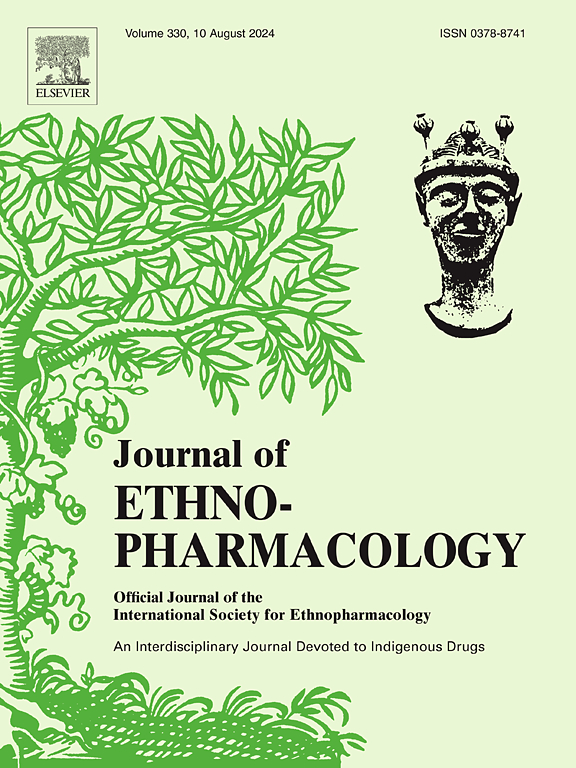Ginsenoside Rb1 alleviates blood-brain barrier damage and demyelination in experimental autoimmune encephalomyelitis mice by regulating JNK/ ERK/NF-κB signaling pathway
IF 4.8
2区 医学
Q1 CHEMISTRY, MEDICINAL
引用次数: 0
Abstract
Ethnopharmacological relevance
The traditional Chinese herb Panax ginseng recorded in "Shennong Herbal Classic" is renowned for its purported vascular regulatory properties and immune-enhancing capabilities. Ginsenoside Rb1 (Rb1), a prominent bioactive compound in Panax, has demonstrated significant neuropharmacological activities. However, its impact on multiple sclerosis (MS) and blood-brain barrier (BBB) damage remains inadequately investigated.
Aim of the study
Inflammation and BBB disruption are pivotal to MS. Tightly packed brain capillary endothelial cells are fundamental to the structural and functional integrity of the BBB. Rb1 has been shown to alleviate BBB damage in stroke rats, but its effect on BBB damage in MS is not well understood. The objective of this study was to examine the role and mechanism of Rb1 on BBB injury in experimental autoimmune encephalomyelitis (EAE) mice.
Materials and methods
The BBB protection effect and mechanism of Rb1 were evaluated in LPS-treated bEnd.3 cells and EAE model mice. The mRNA expression levels of the inflammatory factor and the protein expressions of matrix metalloproteinases 9 (MMP9), zona occludens 1 (ZO-1), inhibitor of NF-κB (IκBα), occludin, Jun-amino-terminal kinase (JNK), and nuclear factor-κB (NF-κB) in bEnd.3 cells and mouse cerebral cortex were quantified. The permeability of bEnd.3 cells was examined by measuring trans-endothelial electrical resistance (TEER) and sodium fluorescein (NaF) leakage.
Results
Rb1 administration in the early stages of EAE postponed the disease's onset and lessened its severity. Rb1 inhibited the destruction of the BBB in brain cortex of EAE mice. Rb1 reduced the lipopolysaccharide (LPS)-induced hyperpermeability of bEnd.3 cells and prevented the downregulation of TJ proteins. In addition, in LPS-induced bEnd.3 cells, Rb1 decreased the overproduction of reactive oxygen species. Moreover, Rb1 suppressed the phosphorylation of JNK, ERK, NF-κB, and IκB in vivo and in vitro. Furthermore, the JNK agonist anisomycin was observed to partially abolish the protective effect of Rb1 in bEnd.3 cells treated with LPS.
Conclusions
Taken together, we demonstrated that Rb1 improved demyelination and BBB damage in EAE mice by modulating JNK/ERK/NF-κB signaling pathway. This study can offer a theoretical foundation for the use of Rb1 in the treatment of MS/EAE by preventing BBB injury.

求助全文
约1分钟内获得全文
求助全文
来源期刊

Journal of ethnopharmacology
医学-全科医学与补充医学
CiteScore
10.30
自引率
5.60%
发文量
967
审稿时长
77 days
期刊介绍:
The Journal of Ethnopharmacology is dedicated to the exchange of information and understandings about people''s use of plants, fungi, animals, microorganisms and minerals and their biological and pharmacological effects based on the principles established through international conventions. Early people confronted with illness and disease, discovered a wealth of useful therapeutic agents in the plant and animal kingdoms. The empirical knowledge of these medicinal substances and their toxic potential was passed on by oral tradition and sometimes recorded in herbals and other texts on materia medica. Many valuable drugs of today (e.g., atropine, ephedrine, tubocurarine, digoxin, reserpine) came into use through the study of indigenous remedies. Chemists continue to use plant-derived drugs (e.g., morphine, taxol, physostigmine, quinidine, emetine) as prototypes in their attempts to develop more effective and less toxic medicinals.
文献相关原料
公司名称
产品信息
阿拉丁
trichloroacetic acid (TCA)
 求助内容:
求助内容: 应助结果提醒方式:
应助结果提醒方式:


